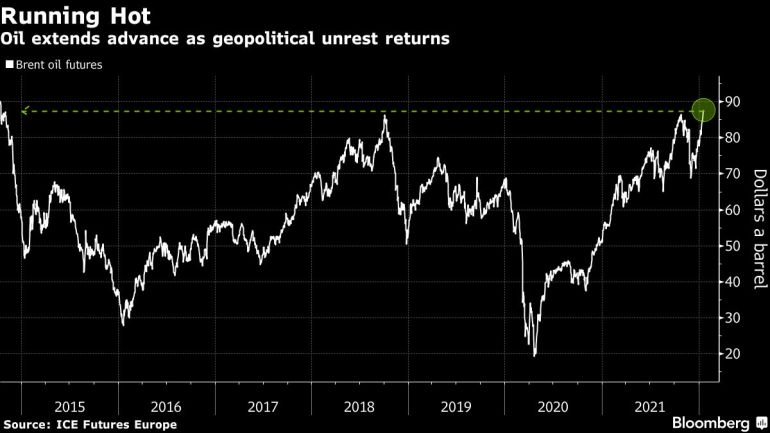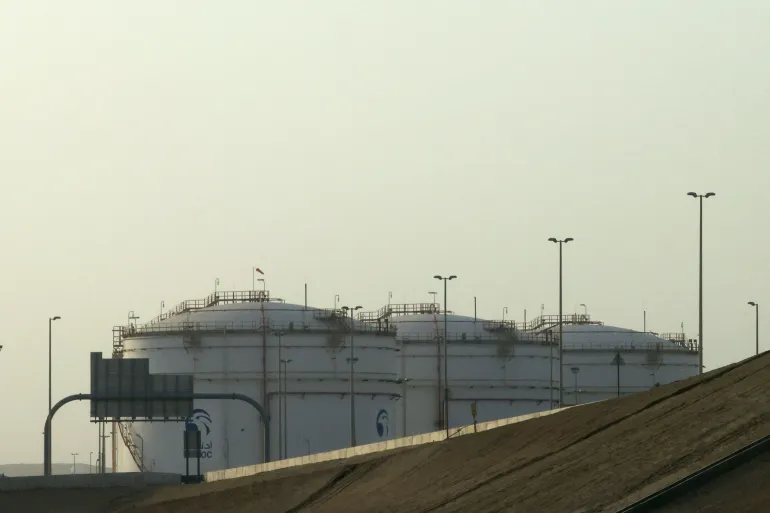Fears fade about the demand impact from Omicron, while supplies are tightened by a range of outages.
By Elizabeth Low and Grant Smith /Bloomberg
Brent oil surged to the highest level in seven years as robust demand and strained supplies make physical markets run hot in the world’s largest consuming region.
Futures in London surged to $88.13 a barrel, the highest since October 2014. Traders are paying higher and higher premiums for cargoes in Asia, as fears fade over the demand impact from omicron, while supplies are tightened by a range of outages from Libya to North America. A drone attack on oil facilities in the UAE on Monday flared geopolitical risks.
Goldman Sachs Group Inc. raised its Brent forecasts through 2022 and 2023 and predicted $100 oil in the third quarter. Robust fundamentals have reversed last year’s price slump, keeping the market in a surprisingly large deficit, it said.
“Demand destruction from omicron has been less than feared, but the main drivers are on the supply side,” said Giovanni Staunovo, an analyst at UBS Group AG in Zurich. “Demand keeps rising and spare capacity keeps falling, so that should keep prices supported this year.”
Oil’s rally poses a challenge for consuming nations and central banks as they try to stave off inflation while supporting global growth. In particular, it’s a headache for President Joe Biden as his efforts to tame gasoline prices by tapping emergency stockpiles — and by cajoling OPEC — fail to yield results.

Crude has made a red-hot start to the year with outages at producers including Libya adding to the bullishness brought about by strong demand. There are upbeat signals from across the oil complex, from diesel to jet fuel, which is soaring in Europe as air travel withstands the omicron impact. The Organization of Petroleum Exporting Countries is set to release its monthly report later Tuesday, providing its snapshot of the market.
The physical-market strength has been compounded by renewed tension in the Persian Gulf, home to about 40% of the world’s seaborne oil.
Yemen’s Houthi fighters claimed to have launched a drone strike on the United Arab Emirates that caused an explosion and fire on the outskirts of the capital Abu Dhabi. The nation is the third-largest producer in OPEC.
“Sentiment in the market remains constructive, and the attack on the UAE has offered only a further boost to prices,” said Warren Patterson, the head of commodities strategy at ING Groep NV. “Supply disruptions coupled with firm demand has meant that the oil market is tighter than expected.”
Prices
- Brent for March settlement was 92 cents higher at $87.40 a barrel on the ICE Futures Europe exchange at 12:06 p.m. London time. It earlier reached the highest level since October 2014.
- The prompt timespread was 71 cents a barrel in backwardation, compared with 74 cents a week earlier.
- West Texas Intermediate for February delivery gained $1.23 from Friday’s close to $85.05 on the New York Mercantile Exchange.
- There was no settlement Monday due to the Martin Luther King Jr. Day holiday in the U.S. and transactions will be booked Tuesday.
Other market news:
- China is still working out details on when and how much oil to release from its strategic reserves as the nation takes baby steps to realize a U.S.-led plan to curb rising energy costs.
- OPEC+ has done a lot to bring about energy-market stability and other oil producers should follow suit, Saudi Arabian Energy Minister Prince Abdulaziz bin Salman said in Dubai.
- Oil driller Vista increased its acreage in Argentina’s Vaca Muerta shale formation by taking full ownership of two ventures with Wintershall DEA.
Source: Bloomberg/ Al Jazeera


